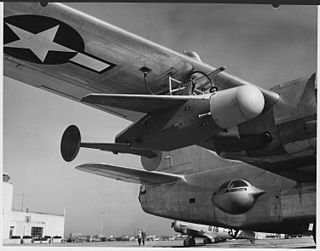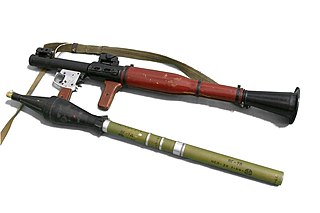
A rocket-propelled grenade is a shoulder-fired anti-tank weapon system that fires rockets equipped with an explosive warhead. Most RPGs can be carried by an individual soldier. These warheads are affixed to a rocket motor which propels the RPG towards the target and they are stabilized in flight with fins. Some types of RPG are reloadable with new rocket-propelled grenades, while others are single-use. RPGs, with some exceptions, are generally loaded from the muzzle.

The T-84 is a Ukrainian main battle tank (MBT), a development of the Soviet T-80 main battle tank introduced in 1976. The T-84 was first built in 1994 and entered service in the Ukrainian Armed Forces in 1999. The T-84 is based on the diesel-engined T-80 version, the T-80UD. Its high-performance opposed-piston engine makes it one of the fastest MBTs in the world, with a power-to-weight ratio of about 26 horsepower per tonne. The T-84 Oplot is an advanced version incorporating an armoured ammunition compartment in a new turret bustle; ten of these entered Ukrainian service in 2001. The T-84-120 Yatagan is a prototype model intended for export, mounting a 120 mm gun capable of firing standard NATO ammunition and guided missiles.

The HJ-8 or Hongjian-8 is a second generation tube-launched, optically tracked, wire-guided anti-tank missile system which was originally deployed by the Chinese People's Liberation Army since the late 1980s.

The RAC 112 APILAS, commonly designated APILAS, is a portable one-shot 112 mm recoilless anti-tank weapon, designed in France by GIAT Industries. Over 120,000 of the APILAS launchers have been produced, and they are in service with many countries.
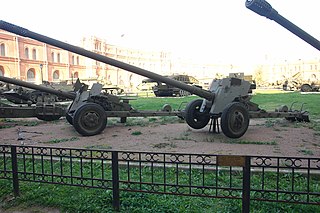
2A19 or T-12 is a Soviet smoothbore 100-mm anti-tank gun, which served as the primary towed anti-tank artillery in the Soviet and Bulgarian armies from the early 1960s to the late 1980s.
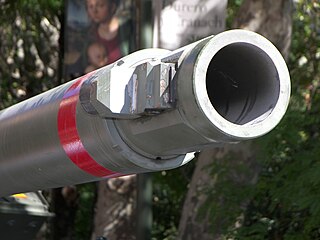
The Rheinmetall Rh-120 is a 120 mm smoothbore tank gun designed and produced by the West German Rheinmetall-DeTec AG company, developed in response to Soviet advances in armor technology and development of new armored threats. Production began in 1974, with the first version of the gun, known as the L/44 as it was 44 calibers long, used on the German Leopard 2 tank and soon produced under license for the American M1A1 Abrams and other tanks. The American version, the M256, uses a coil spring recoil system instead of a hydraulic system. The 120-millimeter (4.7 in) gun has a length of 5.28 meters (17.3 ft), and the gun system weighs approximately 3,317 kilograms (7,313 lb).

The Al-Khalid is a main battle tank jointly developed by Pakistan and China during the 1990s, based on the Chinese Type 90-IIM tank. The original prototype was developed by China North Industries Corporation (Norinco) under the name MBT-2000, and Norinco also offered the tank for export. Around 310 Al Khalid MBTs had been produced by 2014. The Bangladesh Army ordered 44 MBT-2000s from China in 2011. The Norinco-made MBT-2000 is also used by the Royal Moroccan Army. It was trialled by the Peruvian Army for possible acquisition, but was not purchased due to financial problems.

The 9M119 Svir, 9M119M Refleks and AT-11 Sniper by NATO are laser beam riding, guided anti-tank missiles developed in the former Soviet Union. The two missiles are similar, but vary in range and launch platform. Both are designed to be fired from smooth bore 125 mm tank and anti-tank guns. Their NATO reporting name is AT-11Sniper. The name Svir comes from the River Svir, while Refleks means reflex. The 9M119 replaces, or supplants, the 9K112 Kobra.

The National Engineering and Scientific Commission (NESCOM) is a civilian controlled scientific and engineering organization of Pakistan, responsible for carrying out research and development in many areas including information technology, fluid dynamics, aerodynamics, aerospace engineering, electrical engineering, mechanical engineering and chemical engineering, with specialties in the design and production of communication systems and aerodynamic vehicles for the Pakistan Armed Forces. It is under the administrative control of the Strategic Plans Division of Pakistan's National Command Authority and is headquartered in Islamabad, Pakistan.

The Khan Research Laboratories, previously known at various times as Project-706, Engineering Research Laboratories, and Kahuta Research Laboratories, is a Pakistan Government's multi-program national research institute, managed and operated under the scrutiny of Pakistan Armed Forces, located in Kahuta, Punjab Province. The laboratories are one of the largest science and technology institutions in Pakistan, and conduct multidisciplinary research and development in fields such as national security, space exploration, and supercomputing.
Samar Mubarakmand, is a Pakistani nuclear physicist known for his research in gamma spectroscopy and experimental development of the linear accelerator.

The Shaheen-II is a land-based supersonic surface-to-surface medium-range guided ballistic missile. The Shaheen-II is designed and developed by the NESCOM and the National Defence Complex (NDC) of Pakistan. The Shaheen missile series is named after a falcon that lives in the mountains of Pakistan. It is suspected to be a derivative of Chinese M-18 missile, a two-stage missile based on the M-9.
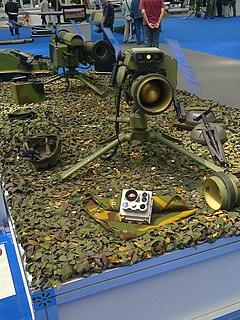
The BUMBAR is a short-range portable anti-tank missile system developed and produced by Serbia.

The Shaheen-I, is a land-based supersonic and short-to-medium range surface-to-surface guided ballistic missile jointly designed and developed by the joint venture of NESCOM and the National Defence Complex (NDC).

The missile research and development program was the Pakistan Ministry of Defence secretive program for the comprehensive research and the development of guided missiles. Initiatives began in 1987 in a direct response to equivalent program existed in India and was managed under the scrutiny of the Ministry of Defence in close coordination with the other related institutions.

The Al-Zarrar, is a second generation main battle tank (MBT), currently in the services of the Pakistan Army since 2004. The tank is named as Al-Zarrar, which means "main striker" in Arabic and Persian languages.

The HAL Rudra, also known as ALH-WSI, is an armed version of HAL Dhruv. Rudra is equipped with Forward Looking Infrared (FLIR) and Thermal Imaging Sights Interface, a 20 mm turret gun, 70 mm rocket pods, anti-tank guided missiles and air-to-air missiles.

The U-5TS tank gun is a 115 mm-calibre weapon that was fitted exclusively to the Soviet Union's T-62 main battle tank. It was the first smoothbore weapon designed for tanks and heralded the change in main armament from rifled cannons.

The post–Cold War era is the period in world history from the collapse of the Soviet Union in 1991 to the present. During the Cold War (1945–1990), the Soviet domination of the Warsaw Pact led to effective standardization on a few tank designs. In comparison, France, Germany, the United States, and the United Kingdom had previously developed their own tank designs, but now tried to standardize their designs, while the smaller nations of NATO purchased or adapted these designs.






